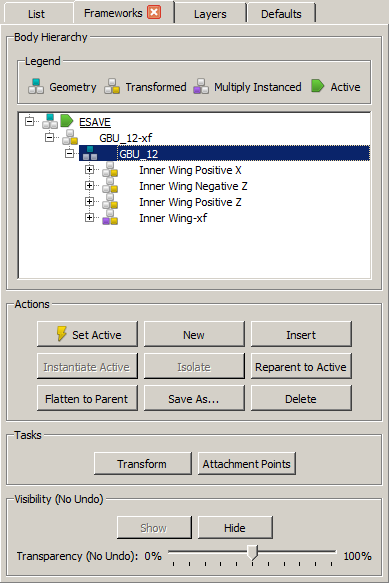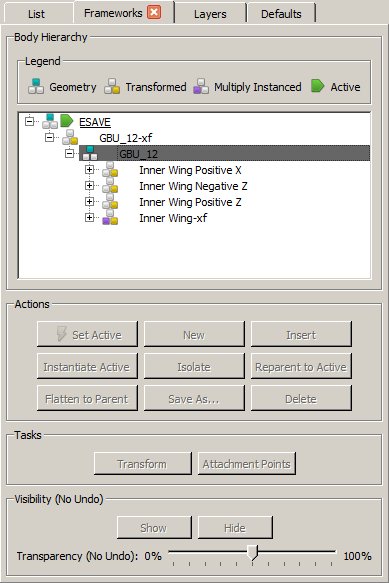Description
The Frameworks panel provides the necessary tools for creating, manipulating and controlling the display of frameworks. Frameworks provide a mechanism for creating independent grid systems within a single instance of Fidelity Pointwise. Each framework can have its own local coordinate system which relates to the global coordinates via attachment points and a transformation. Grid entities will not be merged between separate frameworks. Only those entities within a single framework are connected and subject to automatic merging. Frameworks dramatically facilitate the creation and maintenance of overset style grids which can be made up of a library of components, each being created relative to its own local coordinates. See the Overset command for overset specific tools.
Note: When the Frameworks panel has focus, only frameworks can be selected in the Display window.

The Body Hierarchy frame contains a Legend and a tree view of the current framework system. The Legend area shows the various icon colors and what the represent, in addition to the green arrow style icon which indicates the currently active framework. The icon with a teal square indicates a framework containing geometry. The icon with a yellow square indicates a framework containing a transformation. Finally, the icon with a purple square indicates a framework containing multiply instanced entities. Each of these colors occupies a different position in the icon allowing them to be combined as necessary to represent the state of each framework.
The framework denoted with the green-colored arrow-shaped pentagon is the active framework. This means that all new entities will belong to that framework, will be created in that framework's local coordinates and only entities in that framework are available for selection and to be operated on. There are a few exceptions where selection is allowed from inactive frameworks, such as the Create, Automatic Volume Mesh, Create, Build Refinement and Create, Cut Planes commands.
In the example above, note that each of the instanced occurrences of Inner Wing are held within an intermediate framework with description ending in -xf. This is considered a best practice to incorporate a framework level for the sole purpose of applying a transformation. This separates the entities in the framework below from the transformation, allowing further future instances of the same entities to be unencumbered by an existing transformation.
Tip: Note that all of the Actions commands provide tooltip text which can give insight when a particular command is not available or indication of the action taken by the given command when available.
The Actions command frame provides a number of tools for operating on specific selected frameworks. One or more frameworks must be selected either in the Display window or in the Body Hierarchy tree for Actions commands to be available. Set Active makes the currently selected framework the active framework. Only entities in the active framework can be selected, and newly created entities will exist in the active framework. Only a single framework can be selected for the Set Active command to be available.
New creates a new framework directly under the currently selected framework. Insert creates a new framework directly above the currently selected framework between it and its parent. Instantiate Active will create a new instance framework of the currently active framework below the currently selected framework. There cannot be an existing instance of the active framework already below the selected framework. Additionally, as noted above, if a transformation of the instance is desired, it is best to have an existing intermediate framework which is transformed in order to separate instances from transformations.
Isolate will take the currently selected, instanced framework and "de-instance" it. Basically, a non-instanced copy of the selected framework is created at the instanced framework's physical location. Reparent to Active takes the currently selected frameworks and repositions them in the hierarchy directly below the currently active framework. Flatten to Parent will collapse the entities within the currently selected frameworks into their parent. Any flattened frameworks without children will be deleted.
Use Save As... to export the contents of the selected frameworks to a new .pw native file. Finishing up the Actions command frame is Delete, which will discard the selected frameworks and contents.
The Tasks command frame provides access to two commands related specifically to framework operations: Attachment Points and Transform Framework.
The Visibility (No Undo) command frame provides tools to Hide the contents of selected frameworks. Those affected entities will no longer be visible, reducing visual clutter in the Display window. Frameworks hidden in this manner will be shown in the in the hierarchy tree with a gray background highlight, as shown in the figure below. Hidden frameworks can subsequently be selected in the tree and shown again via Show. At the bottom of the Visibility (No Undo) command frame is the Transparency (No Undo) slider control. By default non-active framework instances are rendered with partial transparency providing a strong visual cue as to which entities are in the currently active framework and which are not. The currently active framework is always rendered at zero percent (0%) transparency no matter the transparency setting previously selected. Simply select a set of frameworks in the tree and adjust the slider control to change their transparency level.

For more on the framework Tasks commands, choose a topic below: